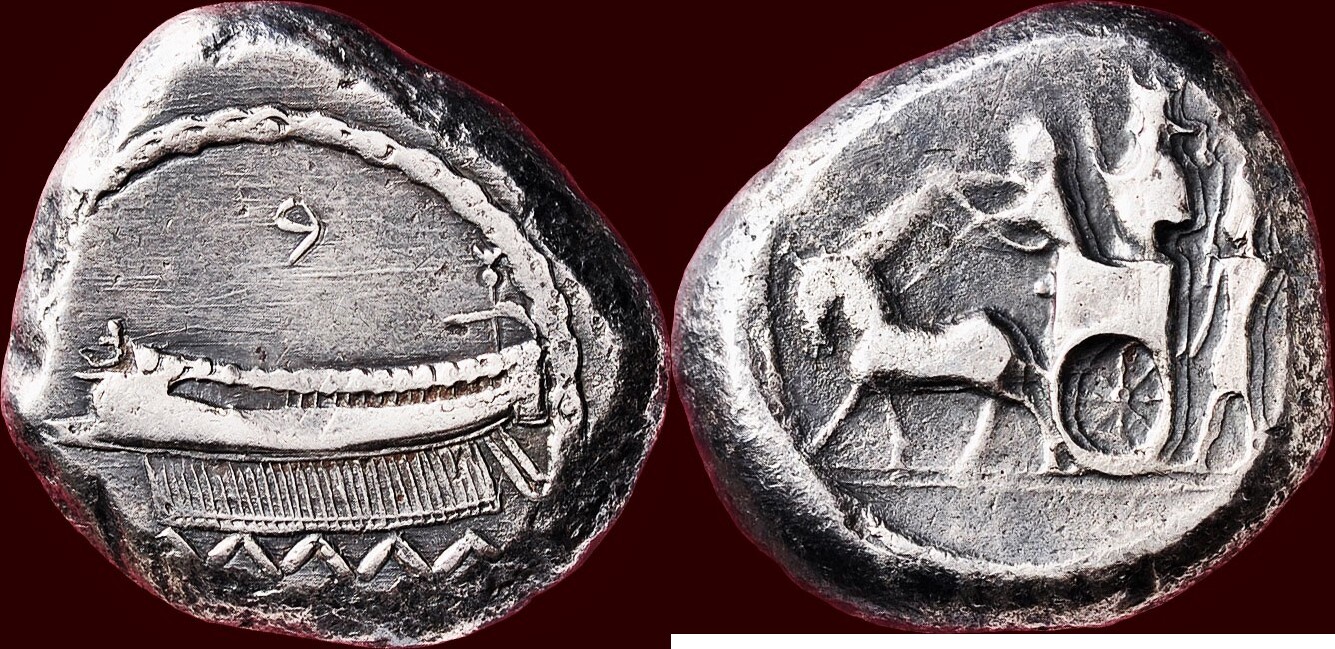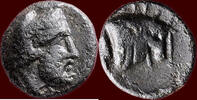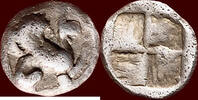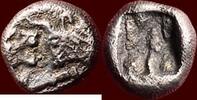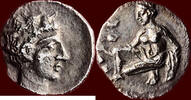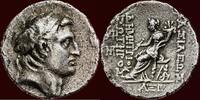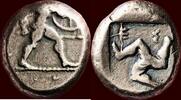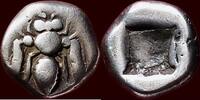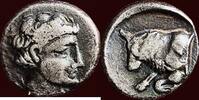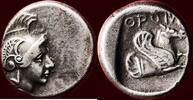MA-ID: 7596802010
Bewertungen Henzen
Schnelle Lieferung. Super Ware. Vielen Dank!
O.K.
perfekt !!!
Great coin, quick delivery, thanks!
407-372 BC v. Chr. PHOENICIA, SIDON - BA′ ALSHILLEM, circa 407-372 BC - AR Dishekel Struck with worn reverse dies, but with an excellent s detailed obverse
Munthandel G.Henzen 

10
Seit 10 Jahren bei MA-Shops
7244 Bewertungen,
100 % Positiv (seit 24 Monaten)
Weltweiter Versand
3350,00 EUR
Differenzbesteuert nach §25a UStG
zzgl. 18,00 EUR Versand ( nach Deutschland )
Lieferzeit: 5 - 8 Tage*
zzgl. 18,00 EUR Versand ( nach Deutschland )
| Bestellhotline +49 (0)2871 2180 383 |
| Zahlungsarten |
| Überweisung |
Struck with worn reverse dies, but with an excellent s detailed obverse | Abkürzungen
Sidon
28,00 mm
weight 27,45gr. | silver Ø 28mm.
obv. War-galley travelling left, propelled by row of oars
shields along bulwarks, standard at stern, beneath lines of zig-zag waves,
above Phoenician letter ″B″
rev. Bearded deity , his right hand raised, standing in horsedrawn car,
slowly driven by charioteer | behind the King of Sidon walking left,
holding animal-headed sceptre
Sidon was one of the two leading cities (with Tyre) of ancient Phoenicia. Sidon is located about 35 km. north of Tyre on the Mediterranean coast of modern Lebanon. History of the site goes back to the 4th millenium BC. The Kindom of Sidon started with Ba′al-hanunu I (1209-1197 BC) and ended with Ešmunšillah III (37-60 AD). Like Tyre, it was a commercial city and port for fleet of military ships and trading ships that went to all parts of the world of that time. The city was famous for the commercial exploitation of the purple (Murex). Sidon′s fortunes improved during the Persian period (539-332 BC). His coinage appears to have started in de second half of the fifth century BC and lasted until the Macedonian conquest in 332 BC. In 351 BC, on the enthronement of Artaxerxes III Ochus in Persia, Sidon revolted. King Tennes led Sidon in rebellion, but when the Persians reacted and the cause looked hopeless Tennes treacherously betrayed Sidon in order to save himself. The city was burned and, although rebuilt, did not regain its former position. Sidon quickly submitted to Alexander the Great in 332 BC and assisted him in the siege of Tyre. During the Hellenistic and Roman periods Sidon was a prosperous centre for commerce and learning.
The penteconter was an ancient Greek galley in use since the archaic period. In contrast to the ships of the Homeric poems, used to transport warriors to the battlefield, penteconters were designed to fight at sea. They had a heavy metal ram at the bow to pierce the hull of the enemy. Speed and maneuverability were key to their design. Naval historians reconstruct their design partly from written sources, from inscriptions, and from the visual arts. In present understanding, the fifty of the penteconter′s name refers to the number of oars on each side. They were arranged in two banks of twenty-five, one hundred oars in total. A midship mast with sail could also propel the ship under favorable wind. Penteconters were longer than merchant ships. They had a deck for carrying armored warriors (hoplite). According to some contemporary calculations, penteconters are believed to have been between 28 and 33 m long, approximately 4 m wide, and capable of reaching a top speed of 9 knots (17 km/h).
BMC 17-24 | SNG.Copenhagen 194 | Mitchiner ACW.132 |
Elayi & Elayi 625 | Betlyon 16-18 | Rouvier 1096 |
HGC 236 | Sear 5934 R
Struck with worn reverse dies, but with an excellent fine detailed obverse
which shows us a beautiful Phoenician war galley. Rare historical coin.
vf+/vf-
obv. War-galley travelling left, propelled by row of oars
shields along bulwarks, standard at stern, beneath lines of zig-zag waves,
above Phoenician letter ″B″
rev. Bearded deity , his right hand raised, standing in horsedrawn car,
slowly driven by charioteer | behind the King of Sidon walking left,
holding animal-headed sceptre
Sidon was one of the two leading cities (with Tyre) of ancient Phoenicia. Sidon is located about 35 km. north of Tyre on the Mediterranean coast of modern Lebanon. History of the site goes back to the 4th millenium BC. The Kindom of Sidon started with Ba′al-hanunu I (1209-1197 BC) and ended with Ešmunšillah III (37-60 AD). Like Tyre, it was a commercial city and port for fleet of military ships and trading ships that went to all parts of the world of that time. The city was famous for the commercial exploitation of the purple (Murex). Sidon′s fortunes improved during the Persian period (539-332 BC). His coinage appears to have started in de second half of the fifth century BC and lasted until the Macedonian conquest in 332 BC. In 351 BC, on the enthronement of Artaxerxes III Ochus in Persia, Sidon revolted. King Tennes led Sidon in rebellion, but when the Persians reacted and the cause looked hopeless Tennes treacherously betrayed Sidon in order to save himself. The city was burned and, although rebuilt, did not regain its former position. Sidon quickly submitted to Alexander the Great in 332 BC and assisted him in the siege of Tyre. During the Hellenistic and Roman periods Sidon was a prosperous centre for commerce and learning.
The penteconter was an ancient Greek galley in use since the archaic period. In contrast to the ships of the Homeric poems, used to transport warriors to the battlefield, penteconters were designed to fight at sea. They had a heavy metal ram at the bow to pierce the hull of the enemy. Speed and maneuverability were key to their design. Naval historians reconstruct their design partly from written sources, from inscriptions, and from the visual arts. In present understanding, the fifty of the penteconter′s name refers to the number of oars on each side. They were arranged in two banks of twenty-five, one hundred oars in total. A midship mast with sail could also propel the ship under favorable wind. Penteconters were longer than merchant ships. They had a deck for carrying armored warriors (hoplite). According to some contemporary calculations, penteconters are believed to have been between 28 and 33 m long, approximately 4 m wide, and capable of reaching a top speed of 9 knots (17 km/h).
BMC 17-24 | SNG.Copenhagen 194 | Mitchiner ACW.132 |
Elayi & Elayi 625 | Betlyon 16-18 | Rouvier 1096 |
HGC 236 | Sear 5934 R
Struck with worn reverse dies, but with an excellent fine detailed obverse
which shows us a beautiful Phoenician war galley. Rare historical coin.
vf+/vf-
Bitte beachten Sie unsere Mindestabnahme von 20 Euro. Sendungen nach China sind auf Gefahr des Käufers und nur Zahlung per banküberweisung. An PayPal und Kreditkarte Zahlungen sind immer Verwaltungs- und Risikokosten verbunden. Sendungen nach Russland, Ukraine und israel sind nicht möglich. Der Versand erfolgt innerhalb von 5 Tagen nach Zahlungseingang. BITTE KEIN PAYPAL ODER KREDITKARTE ZAHLUNGEN FÜR EU. Zahlen Sie bitte immer nur mit IBAN; schnell, billig und zuverlässich.
| Versandkosten | ||||
|---|---|---|---|---|
| bis 100,00 EUR | 100,00 EUR bis 500,00 EUR | 500,00 EUR bis 1000,00 EUR | über 1000,00 EUR | |
| Argentinien | 32,00 EUR | 32,00 EUR | 40,00 EUR | 40,00 EUR |
| Australien | 35,00 EUR | 35,00 EUR | 40,00 EUR | 40,00 EUR |
| Belgien | 9,50 EUR | 11,00 EUR | 13,00 EUR | 18,00 EUR |
| Brasilien | 55,00 EUR | 55,00 EUR | 55,00 EUR | 55,00 EUR |
| Bulgarien | 14,00 EUR | 16,00 EUR | 35,00 EUR | 45,00 EUR |
| Chile | 50,00 EUR | 50,00 EUR | 50,00 EUR | 50,00 EUR |
| China | 40,00 EUR | 40,00 EUR | 50,00 EUR | 50,00 EUR |
| Dänemark | 11,50 EUR | 13,00 EUR | 16,00 EUR | 20,00 EUR |
| Deutschland | 9,50 EUR | 11,00 EUR | 13,00 EUR | 18,00 EUR |
| Estland | 13,00 EUR | 14,00 EUR | 15,00 EUR | 25,00 EUR |
| Frankreich | 9,50 EUR | 11,00 EUR | 16,00 EUR | 25,00 EUR |
| Griechenland | 15,00 EUR | 25,00 EUR | 30,00 EUR | 35,00 EUR |
| Großbritannien | 25,00 EUR | 25,00 EUR | 26,00 EUR | 28,00 EUR |
| Hong Kong | 40,00 EUR | 40,00 EUR | 50,00 EUR | 50,00 EUR |
| Indien | 35,00 EUR | 35,00 EUR | 40,00 EUR | 50,00 EUR |
| Indonesien | 35,00 EUR | 35,00 EUR | 40,00 EUR | 40,00 EUR |
| Israel | 200,00 EUR | 200,00 EUR | 200,00 EUR | 200,00 EUR |
| Japan | 40,00 EUR | 40,00 EUR | 40,00 EUR | 40,00 EUR |
| Kambodscha | 65,00 EUR | 65,00 EUR | 65,00 EUR | 65,00 EUR |
| Kanada | 30,00 EUR | 30,00 EUR | 35,00 EUR | 35,00 EUR |
| Liechtenstein | 20,00 EUR | 20,00 EUR | 25,00 EUR | 25,00 EUR |
| Luxemburg | 11,00 EUR | 13,00 EUR | 16,00 EUR | 25,00 EUR |
| Malaysia | 35,00 EUR | 35,00 EUR | 40,00 EUR | 45,00 EUR |
| Niederlande | 8,50 EUR | 8,50 EUR | 11,00 EUR | 14,00 EUR |
| Norwegen | 25,00 EUR | 25,00 EUR | 30,00 EUR | 35,00 EUR |
| Österreich | 11,50 EUR | 12,50 EUR | 15,00 EUR | 25,00 EUR |
| Polen | 13,00 EUR | 14,00 EUR | 16,50 EUR | 25,00 EUR |
| Portugal | 13,00 EUR | 14,00 EUR | 18,00 EUR | 25,00 EUR |
| Rumänien | 16,00 EUR | 18,00 EUR | 25,00 EUR | 35,00 EUR |
| Russische Föderation | 200,00 EUR | 200,00 EUR | 200,00 EUR | 200,00 EUR |
| Schweiz | 30,00 EUR | 30,00 EUR | 40,00 EUR | 40,00 EUR |
| Serbien | 25,00 EUR | 25,00 EUR | 30,00 EUR | 35,00 EUR |
| Singapur | 35,00 EUR | 35,00 EUR | 35,00 EUR | 40,00 EUR |
| Slowakei | 13,00 EUR | 15,00 EUR | 20,00 EUR | 25,00 EUR |
| Spanien | 11,50 EUR | 13,50 EUR | 16,50 EUR | 25,00 EUR |
| Sri Lanka | 35,00 EUR | 35,00 EUR | 40,00 EUR | 45,00 EUR |
| Tschechische Republik | 12,00 EUR | 14,00 EUR | 18,00 EUR | 25,00 EUR |
| Ukraine | 200,00 EUR | 200,00 EUR | 200,00 EUR | 200,00 EUR |
| Ungarn | 14,00 EUR | 16,00 EUR | 25,00 EUR | 30,00 EUR |
| Vereinigte Staaten von Amerika | 32,00 EUR | 32,00 EUR | 35,00 EUR | 40,00 EUR |
| Europäische Union | 15,00 EUR | 17,00 EUR | 25,00 EUR | 30,00 EUR |
| Welt | 40,00 EUR | 40,00 EUR | 50,00 EUR | 50,00 EUR |
Informationen zum Kauf bei MA-Shops
Bestellungen bei MA-Shops sind jederzeit möglich und werden innerhalb von 2-4 Arbeitstagen verschickt.
Ein über die MA-Shops abgesicherter Kauf findet niemals außerhalb von MA-Shops statt.
Bestellen Sie sicher online mit dem MA-Shops Warenkorb.
Vielen Dank.
Ein über die MA-Shops abgesicherter Kauf findet niemals außerhalb von MA-Shops statt.
Bestellen Sie sicher online mit dem MA-Shops Warenkorb.
Vielen Dank.
|
Verkäufer-Startseite | 0Warenkorb | AGB | Impressum | MA AGB | Datenschutzerklärung | Garantie | MA-Shops Neuzugänge Copyright ® 2001-2025, MA-SHOPS Muenzen All Rights Reserved. Designated trademarks and brands are the property of their respective owners. |
 Münzen beim Fachhändler kaufen
Münzen beim Fachhändler kaufen


